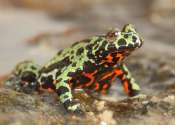Climate change not main driver of amphibian decline
While a warming climate in recent decades may be a factor in the waning of some local populations of frogs, toads, newts and salamanders, it cannot explain the overall steep decline of amphibians, according to researchers.








